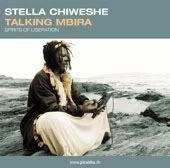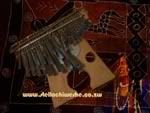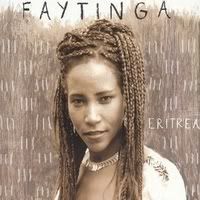We've done it again!
More incredibly sizzling music has been added to our active playlists. As promised there is some Afro-Brazilian berimbau music for Capoeira by masters like Mestre Bimba, Candomble and Samba drumming as well as a little battucada.
Other new music includes Gnawa music from Morocco from Mustapha Baqbou, and we will be adding more Gnawa music in the not too distant future. More tracks include: Kalimba (thumb piano) & Kalimbu (berimbau) music from Zambia, Shona Mbira music from Zimbabwe, music from the Nguni people of South Africa with the Uhadi (gourd bow/fiddle) and flutes, Malian artists Sissokho Yakhouba & Lansine Kouyate on the Kora and Balafon.
More superb M'balax tunes from the likes of Fatou Guewel & Groupe Sope Noreyni, and Mbaye Dieye Faye, as well as unique South African Marimba music and fanatastic drums from Mamadi Bagayogo of the Ivory Coast, Nyanyo Addo of Ghana, Mamoudou Kante of Mali and much more...
Please tune in toKemet Music Radioand enjoy...
Wednesday, March 21, 2007
Tuesday, March 20, 2007
Stella Chisweshe and the Musical Spirituality of the Mbira Dzavadzimu
 Stella Rambisai Chiweshe was born in Mujumi Village in Mhondoro, Zimbabwe in 1946 and is the great grand daughter of Munaka, a resistance fighter who was eventually hung by the British. She is an internationally known musician, well respected for her singing and playing of the mbira dzavadzimu (or mbira 'of the ancestors').
Stella Rambisai Chiweshe was born in Mujumi Village in Mhondoro, Zimbabwe in 1946 and is the great grand daughter of Munaka, a resistance fighter who was eventually hung by the British. She is an internationally known musician, well respected for her singing and playing of the mbira dzavadzimu (or mbira 'of the ancestors').Stella learned to play the mbira between 1966 and 1969 at a time when females who played the mbira was practically unheard of. When she announced her decision to play the mbira, an instrument played exclusively by males, she met with as much resistance from the women as the men. In fact, due to the fact that she was often in the presence of men in order to learn how to play the mbira, the women in her village would look down upon her as being a promiscuous woman. Despite these obstacles, Stella Chiweshe persevered in her unwavering determination to follow her dreams and in doing so, opened the doors for many female musicians in Zimbabwe.
The mbira dzavadzimu is a traditional instrument of the Shona peoples of Zimbabwe that has been used for thousands of years going back to back to time of Chaminuka, who were the Mhondoro or Great Spirit Mediums. There are variations of the mbira in parts of South, Central, West and East Africa as well as Caribbean countries like Cuba, Puerto Rico and Haiti. The mbira is by known other names in other parts of Africa and the Caribbean, for example Kalimba, Mbila, Likembe, and Marimbola. The traditional mbira has 22 iron keys, but can have anywhere from 22-28 keys. Stella refers to her mbira's 23 keys as 23 voices. The keys are mounted on a hardwood soundboard and placed inside a gourd which acts as a resonator. Sometimes shells or other objects are placed on the soundboard of the mbira to create a buzzing noise that's said to attract the ancestor spirits.
 The mbira has a very comforting sound, and at times can be reminiscent of running water. It is considered a sacred instrument and traditionally has been played at religious ceremonies (bira) and at social events (mapira) as well as within the royal Shona Courts. It is often used to communicate with ancestor spirits as well as for healing, guidance and success in battle. In the 'bira' ceremonies, the mbira is combined with the hosho (gourd rattles), singing and sometimes with the ngona (drum). Before the independence of Zimbabwe, Stella would attend these 'secret' ceremonies at night in colonial Zimbabwe (Rhodesia) and go to work as a maid during the day.
The mbira has a very comforting sound, and at times can be reminiscent of running water. It is considered a sacred instrument and traditionally has been played at religious ceremonies (bira) and at social events (mapira) as well as within the royal Shona Courts. It is often used to communicate with ancestor spirits as well as for healing, guidance and success in battle. In the 'bira' ceremonies, the mbira is combined with the hosho (gourd rattles), singing and sometimes with the ngona (drum). Before the independence of Zimbabwe, Stella would attend these 'secret' ceremonies at night in colonial Zimbabwe (Rhodesia) and go to work as a maid during the day.In the liner notes to "Talking Mbira", Chiweshe recalls incidences where individuals who experienced the sound of the mbira would suddenly lose pain that had afflicted them for years. The comforting sound of the mbira gives it a comforting sound, and the liner notes describe audience members have been moved to tears at hearing its rich, melodic tones, but felt as if the their tears were coming from another source within. "People do not truly understand the strength of this power. It can take you completely by surprise." Stella believes in the spiritual power of the mbira and its ability to help one overcome the daily aches and worries of everyday life, after having witnessed its spiritual potency at traditional ceremonies in Zimbabwe.
She recorded her first single named "Kasahwa" in 1974 with a borrowed mbira, and the song was a popular success. This was followed by a string of successful singles over the next 6 years that established her reputation on the international stage. She joined the National Dance Company in 1981 and began to travel to other countries to perform. Stella Chiweshe directs the Mother Earth Trust - Network of Female Artists in Zimbabwe and had an active role in the formation of the Zimbabwe Musicians Union.
In 1989 she acted in the Godwin Mawuru film "I Am the Future", which was about a young woman fleeing to the big city in order to escape Zimbabwe's independence war in the rural areas. Stella has performed in Germany on several occasions and was also a participant in the WOMAD festival (1994 in the United States and 1995 in Australia). Stella performs as a solo artist and with the Stella Chiseshe Mbira Trio and the Earthquake Band. In 2004 she toured England with her daughter, Virginia Mukwesha who has also established a career playing the mbira. You can listen to Stella Rambisai Chiweshe at Kemet Music Radio. Thank you for tuning in.
Discography:
Album: Double Check
Label: Piranha
Year: 2006
Album: Talking Mbira
Label: Piranha
Year: 2002
Album: The Healing Tree
Label: Shanachie
Year: 1998
Album: Ndizvozvo
Label: ??
Year: 1996
Album: Shungu
Label: Piranha
Year: 1994
Album: Kumusha
Label: Pirahna
Year: 1991
Album: Chisi
Label: (Shanachie 1990 / Piranha 1994)
Year: 1990
Album: Ambuya?
Label: (Globestyle 1987 / Piranha 1988)
Year: 1987
Thursday, March 15, 2007
Faytinga: Independent Spirit With Ethereal Voice
 Faytinga, one of Eritrea's best known singers, is a member of the Kunama tribe. Her mother was of Blen descent (a Cushitic speaking people) from the highlands, while her father was a member of the Semitic speaking Tigrinya peoples. She was born in 1964, and was involved in Eiretrea's struggle for independence from Ethiopia since she was 14 years of age. Faytinga's father, Faïïd Tinga, was a war hero and was already a part Eritrea's 30 year liberation struggle at Faytinga's birth.
Faytinga, one of Eritrea's best known singers, is a member of the Kunama tribe. Her mother was of Blen descent (a Cushitic speaking people) from the highlands, while her father was a member of the Semitic speaking Tigrinya peoples. She was born in 1964, and was involved in Eiretrea's struggle for independence from Ethiopia since she was 14 years of age. Faytinga's father, Faïïd Tinga, was a war hero and was already a part Eritrea's 30 year liberation struggle at Faytinga's birth.As a young child, she was often surrounded by music and wished to become a singer. This first started to happen when she began to perform for the soldiers on the frontlines. Faytinga draws upon the musical traditions of Eritrea for her inspiration, using the Krar (a form of lyre, used also in Ethiopia), the bass Krar, the Wata (a traditional one stringed violin/fiddle of which there are many varieties all over Africa) and Bengala (a Kunama Eritrean stringed instrument). While she bases her music on traditional Kunama music, she also uses contemporary instruments, incorporates the guitar and modern percussion in her music.
In 1990, Faytinga took part of an American tour and Europe as a member of an Eritrean musical group and didn't tour as a solo artist until 1995 when she recorded her first album on cassette. After an appearance at the Africolor festival in 1999 she recorded her first CD in 2000. In addition to being a singer, she is also known to be an elegant dancer and represents a source an inspiration to many Eritreans. She sings in Kanama, a Nilo-Saharan language that is over 8,000 years old, and among the oldest languages used in the Horn of Africa. The ancient Meroitic language of Cush (Nubia region of the Nile Valley) has often been classified as a Nilo-Saharan language by many scholars, due in part to the Sudanese origins of some Nilo-Saharan languages such as the Luo family of related ethnic groups (tribes).
Faytinga incorporates the verses of Eritrean poets like Agostino Egidio and Arodi Tulli in her music and has used traditional Kunama songs to remain true to her roots. Her clear, ethereal voice virtually transports you to another world, and her music - drawing upon the musical traditions of her people - creates a uniquely Eritrean East African sound that has established her as one of the shining lights in African music.
Listen to Faytinga on Kemet Music Radio
Discography:
Album: Numey
Label: Africolor/Cobalt
Year: 2000
Album: Faytinga
Label: Africolor/Cobalt
Year: 2003
Thursday, March 8, 2007
More New Music @ Kemet Music Radio
Allright, we've got quite a selection of new music compositions that should be up and running on our active playlists by the beginning of next week (...or a little sooner).
What's New:
As promised, we're adding some Afro-Brazilian Batucada and Batucada Capoeira music with some very intense drumming, as well as Samba and Condomble ceremonial drumming from the Brazilian descendants of the Yoruba people of West Africa. I've also added some uplifting ceremonial drumming from Nigeria, Mali, Guinea, etc...
Also included, is Capoeira music, including the 'Angola' style, played with the Brazilian Berimbau by artists like Mestre Bimba, and Mestrando Charm.
There's much more traditional African music on the way as well: featuring musicians from Zimbabwe, Nigeria, Mali, Tanzania, South Africa playing the Mbira, Agidigbo, Kora, Marimba, and Uhadi respectively - to name a few examples.
Also on the way are some modern tracks featuring African musicians who use instruments like these, and you can hear them all on Kemet Music Radio
Keep checking our blog for more upcoming artist reviews. Thanks for tuning in...
Pianki
pianki@kemetmusicradio.com
What's New:
As promised, we're adding some Afro-Brazilian Batucada and Batucada Capoeira music with some very intense drumming, as well as Samba and Condomble ceremonial drumming from the Brazilian descendants of the Yoruba people of West Africa. I've also added some uplifting ceremonial drumming from Nigeria, Mali, Guinea, etc...
Also included, is Capoeira music, including the 'Angola' style, played with the Brazilian Berimbau by artists like Mestre Bimba, and Mestrando Charm.
There's much more traditional African music on the way as well: featuring musicians from Zimbabwe, Nigeria, Mali, Tanzania, South Africa playing the Mbira, Agidigbo, Kora, Marimba, and Uhadi respectively - to name a few examples.
Also on the way are some modern tracks featuring African musicians who use instruments like these, and you can hear them all on Kemet Music Radio
Keep checking our blog for more upcoming artist reviews. Thanks for tuning in...
Pianki
pianki@kemetmusicradio.com
Subscribe to:
Comments (Atom)
